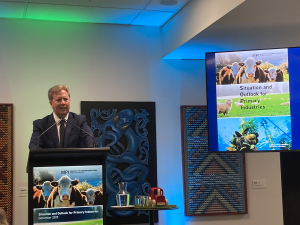There are many examples of the cost of biosecurity failures:
The Australian fruitfly which threatens our $3 billion horticultural export industry;
The Psa bacterium which could cost the kiwifruit industry $1 billion and dozens of jobs;
The destructive varroa bee mite which requires a short term fix by miticide applications costing $50/hive/year to control;
The tomato/potato psyllid destroying tamarillo orchards, costing the industry $100 million;
The clover root weevil.
In addition, as pointed out by Minister of Primary Industries David Carter, the massive response to the recent detection of fruitfly will cost millions of dollars. Though Horticulture NZ chief executive Peter Silcock says it is not the time to cast blame, it is still critical that we find the reasons for these costly failures.
Certainly the Government’s decision to randomly X-ray baggage rather than checking all items at international airports – driven apparently by the tourism sector and the perceived need to speed up passenger entry – must have increased the risk of pest incursions.
Also, as Andrew Fenton, president of Horticulture NZ, has pointed out, the reduction in front line staff of 12% in four years, when passenger numbers have increased by 14 %, cannot be helpful. Further, two former biosecurity officers have said border screening shortcuts have increased the chances of pests such as the Queensland fruitfly entering the country.
Andrew Coleman, of Biosecurity NZ, has responded by saying there are 280 staff at international airports and 180 staff monitoring import health standards in cargo and parcel mail.
He also claimed the system was working because the fruitfly had been found .With respect, that’s a bit late, and it is costing millions of dollars to search for other associated incursions. Of course no system can be foolproof but some recent policies can only increase the risk.
Also, consider the marathon battle between the Ministry of Primary Industries (MPI) and the Pork Industry Board to allow imports of raw pig meat. The industry has already spent $ 1.4 million presenting its case and the High Court has recently ruled in favour of MPI although an appeal is an option.
The problem here is that the scientific advice to the industry is that the proposed imports pose an unacceptable risk of bringing an extremely destructive disease – porcine reproductive respiratory syndrome (PRRS) – into the country. MPI director-general Wayne McNee has said “there is a very slight risk”. Is that acceptable? Unfortunately there are other pressures driving the New Zealand policy and they relate to the Government push for more free trade agreements.
No doubt there is pressure from actual and potential free trade partners for the relaxation of imports of raw pig meat .And our pig industry is very small and presumably regarded as expendable by the Government. It is impossible to believe that if the threat was foot and mouth disease a statement “of a very slight risk” would be acceptable.
The situation with Psa bacterium on kiwifruit and the varroa mite harming bees is different because the way these organisms got into the country is unclear. In the case of Psa, work at Otago University suggests the origin of the disease was probably China. There are several possibilities for the transfer of the disease via plant material, but importations of breeding material are strictly monitored through well developed quarantine systems. The possibility of transfer by pollen has been considered, but an earlier ministry opinion was that “the risk was slight”.
As the disease has been causing severe damage to kiwifruit crops throughout the world for some time, it is unfortunate we have been unable to do the research that might have stopped this incursion. A relatively small investment in pre-border issues might have prevented the enormous costs and disruption now facing the industry and New Zealand.
We know even less about the entry of varroa, though there is a fairly widespread view in the industry that an illegal importation of queens might have carried the mite.
It appears New Zealand has moved to a slightly ‘softer’ position on biosecurity. Certainly the old ‘precautionary principle’ – where restrictions remain in place if there is the slightest risk – has been dumped. The fact our apples were banned for 90 years from export to Australia because of an alleged risk of fireblight does suggest our near neighbour takes a much harder and more effective line than New Zealand. Australia does not have Psa, varroa or the two devastating pig viruses PRRS and PMWS.
It appears neo-liberal moves in recent years by both major parties to less regulation and freer trade has meant we are taking more risks at a time of growing biosecurity threats. .The slight loosening of border controls has led to some expensive search and control measures with the painted apple moth and now fruitfly. In other cases – Psa being a current example – search and control measures have failed.
A simple business case suggests a greater emphasis on offshore prevention and tighter border controls would be more effective and give substantial cost savings over the expensive clean-up required after an incursion has occurred.
• John Lancashire is the immediate past president of the NZ Institute of Agricultural and Horticultural Science.

















